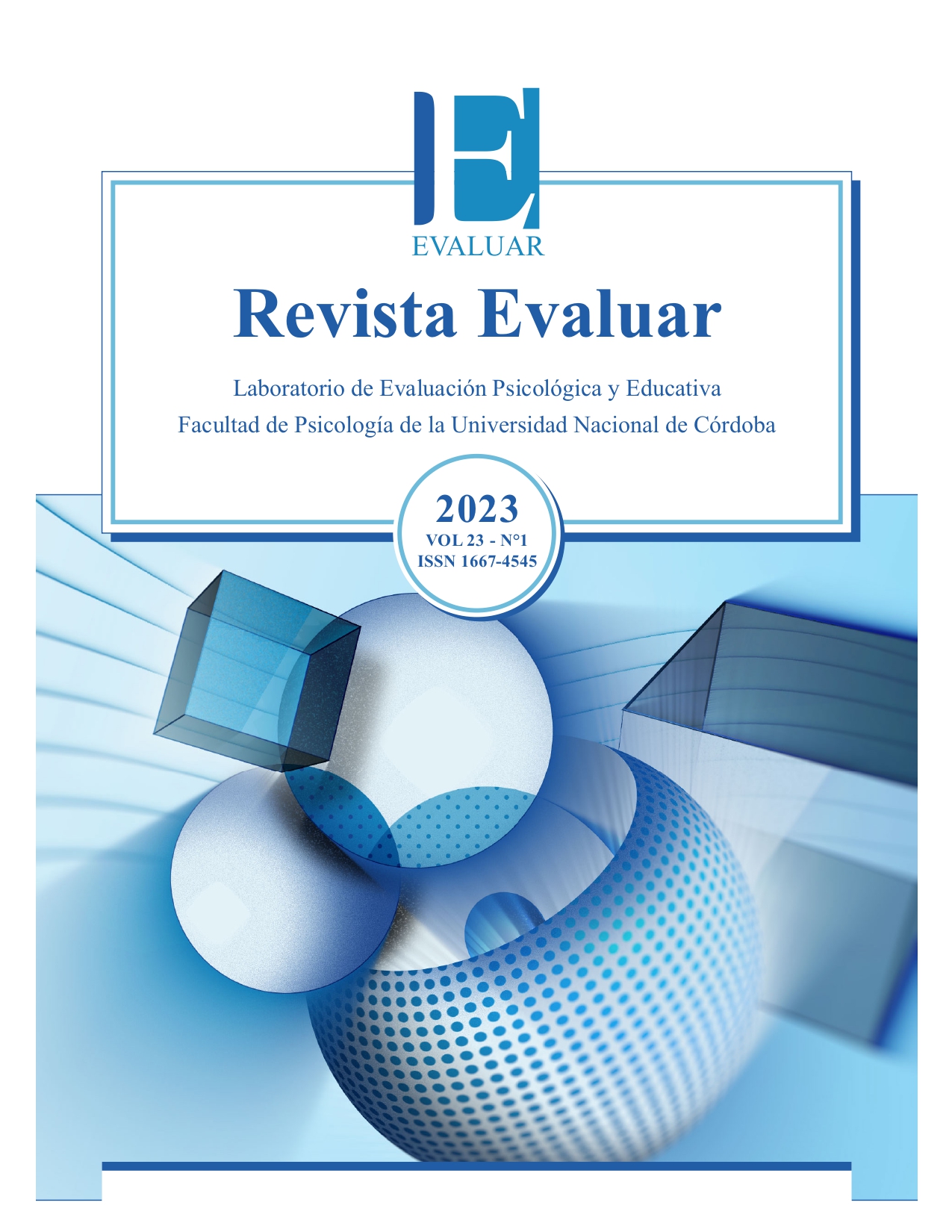Automatic Thinking Questionnaire (ATQ-8): New evidence based on CFA, IRT, and SEM
DOI:
https://doi.org/10.35670/1667-4545.v23.n1.41010Keywords:
thinking, psychometrics, university student, psychological research, cognitionAbstract
The present study aims at providing psychometric properties of the ATQ-8 in a Peruvian students sample. We worked with a non-probabilistic sample of 217 university students (68.7% women). Along with the ATQ-8, instruments to measure anxiety, depression, satisfaction with life, and mindfulness were used. Confirmatory factor analysis found an adequate fit of the one-dimensional model (CFI = .99, GFI = .99, RMSEA = .07, SRMR = .03). Likewise, alpha (.91) and omega (.90) reliability indices were obtained, which show adequate internal consistency. On the other hand, the items showed acceptable levels of discrimination (a) and difficulty (b) monotonous. The association of the ATQ-8 with other variables showed a statistically significant relationship with the DASS-21 (depression and anxiety), satisfaction with life (SWLS) and mindfulness (MAAS-5). The results show an adequate psychometric adjustment that supports its use in university students and for scientific research purposes.
Downloads
References
Arpin-Cribbie, C. A., & Cribbie, R. A. (2007). Psychological correlates of fatigue: Examining depression, perfectionism, and automatic negative thoughts. Personality and Individual Differences, 43(6), 1310-1320. https://doi.org/10.1016/j.paid.2007.03.020
Ato, M., López, J. J., & Benavente, A. (2013). Un sistema de clasificación de los diseños de investigación en psicología. Anales de Psicología, 29(3), 1038-1059. https://doi.org/10.6018/analesps.29.3.178511
Aydin, K. B. (2009). Automatic thoughts as predictors of Turkish university students’ state anxiety. Social Behavior and Personality: An International Journal, 37(8), 1065-1072. https://doi.org/10.2224/sbp.2009.37.8.1065
Beck, A. T., Rush, J. A., Shaw, B. F., & Emery, G. (1979). Cognitive therapy of depression. The Guilford Press.
Bologna, E. (2011). Tendencias en el análisis estadístico: Límites de la inferencia frecuencial y posibilidades del enfoque bayesiano. Revista Evaluar, 11(1). https://doi.org/10.35670/1667-4545.v11.n1.2842
Cai, L., Chung, S. W., & Lee, T. (2021). Incremental model fit assessment in the case of categorical data: Tucker-Lewis index for item response theory modeling. Prevention Science. https://doi.org/10.1007/s11121-021-01253-4
Calderón-De la Cruz, G., Lozano Chávez, F., Cantuarias Carthy, A., & Ibarra Carlos, L. (2018). Validación de la Escala Satisfacción con la Vida en trabajadores peruanos. Liberabit: Revista Peruana de Psicología, 24(2), 249-264. https://doi.org/10.24265/liberabit.2018.v24n2.06
Cano-García, F. J., & Rodríguez-Franco, L. (2002). Evaluación del lenguaje interno ansiógeno y depresógeno en la experiencia de dolor crónico. Apuntes de Psicología, 20(3), 329-346. http://hdl.handle.net/11441/51034
Caycho-Rodríguez, T., García Cadena, C. H., Reyes-Bossio, M., Cabrera-Orosco, I., Oblitas Guadalupe, L. A., & Arias Gallegos, W. L. (2019). Evidencias psicométricas de una versión breve de la Mindful Awareness Attention Scale en estudiantes universitarios. Revista Argentina de Ciencias del Comportamiento, 11(3), 19-32. https://doi.org/10.32348/1852.4206.v11.n3.24870
Chang, K.-H., Lu, F. J. H., Chyi, T., Hsu, Y.-W., Chan, S.-W., & Wang, E. T. W. (2017). Examining the stress-burnout relationship: the mediating role of negative thoughts. PeerJ, 5, e4181. https://doi.org/10.7717/peerj.4181
Cohen, J. (1988). Statistical Power Analysis for the Behavioral Sciences. Lawrence Erlbaum Associates. http://utstat.toronto.edu/~brunner/oldclass/378f16/readings/CohenPower.pdf
Deardorff, P. A., Hopkins, L. R., & Finch, A. J. (1984). Automatic Thoughts Questionnaire: A Reliability and Validity Study. Psychological Reports, 55(3), 708-710. https://doi.org/10.2466/pr0.1984.55.3.708
Dominguez-Lara, S. A. (2018). Propuesta de puntos de corte para cargas factoriales: una perspectiva de fiabilidad de constructo. Enfermería Clínica, 28(6), 401-402. https://doi.org/10.1016/j.enfcli.2018.06.002
Estévez, A. M., & Calvete, E. (2009). Mediación a través de pensamientos automáticos de la relación entre esquemas y síntomas de depresión. Anales de Psicología, 25(1), 27-35. https://revistas.um.es/analesps/article/view/71461
Fernández-Sogorb, A., Freire-Andino, R. O., Aparicio-Flores, M. del P., & García-Fernández, J. M. (2021). Interpersonal difficulties in heterosexual relationships and perfectionist automatic thoughts in Ecuadorian university students. European Journal of Health Research, 1-12. https://doi.org/10.32457/ejhr.v7i1.1389
Furlan, L., Pérez, E., Moyano, M., & Cassady, J. (2010). Propiedades psicométricas y estandarización de la Escala de Ansiedad Cognitiva frente a los Exámenes a la población universitaria argentina. Revista Evaluar, 10(1). https://doi.org/10.35670/1667-4545.v10.n1.457
George, D., & Mallery, P. (2020). IBM SPSS Statistics 26: Step by Step. A Simple Guide and Reference (6ta ed.). Taylor & Francis.
Ghassemzadeh, H., Mojtabai, R., Karamghadiri, N., & Ebrahimkhani, N. (2006). Psychometric properties of a persian-language version of the automatic thoughts questionnaire: ATQ-Persian. International Journal of Social Psychiatry, 52(2), 127-137. https://doi.org/10.1177/0020764006062095
Green, S. B., & Yang, Y. (2009). Reliability of summed item scores using structural equation modeling: An alternative to coefficient alpha. Psychometrika, 74(1), 155-167. https://doi.org/10.1007/s11336-008-9099-3
Hambleton, R. K., van der Linden, W. J., & Wells, C. S. (2010). IRT modes for the analysis of polytomously scored data: Brief and selected history of model building advances. In M. L. Nering & R. Ostini (Eds.), Handbook of Polytomous Item Response Models (pp. 21-42). Routledge.
Hiçdurmaz, D., İnci, F., & Karahan, S. (2017). Predictors of mental health symptoms, automatic thoughts, and self-esteem among university students. Psychological Reports, 120(4), 650-669. https://doi.org/10.1177/0033294117707945
Hollon, S. D., & Kendall, P. C. (1980). Cognitive self-statements in depression: Development of an automatic thoughts questionnaire. Cognitive Therapy and Research, 4(4), 383-395. https://doi.org/10.1007/BF01178214
Hu, L., & Bentler, P. M. (1999). Cutoff criteria for fit indexes in covariance structure analysis: Conventional criteria versus new alternatives. Structural Equation Modeling: A Multidisciplinary Journal, 6(1), 1-55. 5. https://doi.org/10.1080/10705519909540118
Ibáñez-Tarín, C., & Manzanera-Escartí, R. (2012). Técnicas cognitivo-conductuales de fácil aplicación en atención primaria (I). SEMERGEN - Medicina de Familia, 38(6), 377-387. https://doi.org/10.1016/j.semerg.2011.07.019
Lara-Machado, J. R., & Lara-Barros, B. P. (2022). Ansiedad dental y pensamientos automáticos en pacientes odontológicos de la Cruz Roja, provincia de Tungurahua. CienciAmérica, 11(1), 43-55. https://doi.org/10.33210/ca.v11i1.379
Lichtenstein, M. B., Dervisevic, A., Eg, J., Wilson, R., & Wesselhoeft, R. (2019). A psychometric evaluation of the automatic thoughts questionnaire in Danish adolescents and emerging adults. Nordic Psychology, 71(4), 262-275. https://doi.org/10.1080/19012276.2019.1604252
Maydeu-Olivares, A. (2013). Goodness-of-Fit Assessment of Item Response Theory Models. Measurement: Interdisciplinary Research & Perspective, 11(3), 71-101. https://doi.org/10.1080/15366367.2013.831680
Netemeyer, R. G., Williamson, D. A., Burton, S., Biswas, D., Jindal, S., Landreth, S., Mills, G., & Primeaux, S. (2002). Psychometric Properties of Shortened Versions of the Automatic Thoughts Questionnaire. Educational and Psychological Measurement, 62(1), 111-129. https://doi.org/10.1177/0013164402062001008
Oei, T., & Mukhtar, F. (2008). Exploratory and confirmatory factor validation and psychometric properties of the automatic thoughts questionnaire for Malays (ATQ-Malay) in Malaysia. Hong Kong Journal of Psychiatry, 18(3), 92-100. https://espace.library.uq.edu.au/view/UQ:175738
Pan, J.-Y., Ye, S., & Ng, P. (2016). Validation of the Automatic Thoughts Questionnaire (ATQ) Among Mainland Chinese Students in Hong Kong. Journal of Clinical Psychology, 72(1), 38-48. https://doi.org/10.1002/jclp.22193
Park, S. H., Song, Y. J. C., Demetriou, E. A., Pepper, K. L., Thomas, E. E., Hickie, I. B., & Guastella, A. J. (2020). Validation of the 21-item Depression, Anxiety, and Stress Scales (DASS-21) in individuals with autism spectrum disorder. Psychiatry Research, 291, 113300. https://doi.org/10.1016/j.psychres.2020.113300
Pirbaglou, M., Cribbie, R., Irvine, J., Radhu, N., Vora, K., & Ritvo, P. (2013). Perfectionism, anxiety, and depressive distress: Evidence for the mediating role of negative automatic thoughts and anxiety sensitivity. Journal of American College Health, 61(8), 477-483. https://doi.org/10.1080/07448481.2013.833932
R Core Team. (2021). R: A language and environment for statistical computing (Version 4.2.2) [Computer software]. R Foundation for Statistical Computing. https://www.R-project.org
Ruiz, F. J., & Odriozola-González, P. (2016). The role of psychological inflexibility in Beck’s cognitive model of depression. Anales de Psicología, 32(2), 441. https://doi.org/10.6018/analesps.32.2.214551
Ruiz, F. J., Segura-Vargas, M. A., Odriozola-González, P., & Suárez-Falcón, J. C. (2020). Psychometric properties of the Automatic Thoughts Questionnaire-8 in two Spanish nonclinical samples. PeerJ, 8, e9747. https://doi.org/10.7717/peerj.9747
Ruiz, F. J., Suárez-Falcón, J. C., & Riaño-Hernández, D. (2017). Validity Evidence of the Spanish Version of the Automatic Thoughts Questionnaire-8 in Colombia. The Spanish Journal of Psychology, 20, E12. https://doi.org/10.1017/sjp.2017.7
Sancho, P., Caycho-Rodríguez, T., Ventura-León, J., Tomás, J. M., & Reyes-Bossio, M. (2019). Does the Spanish version of the SWLS measure the same in Spain and Peru? Revista Española de Geriatría y Gerontología, 54(6), 329-333. https://doi.org/10.1016/j.regg.2019.04.003
Schumacker, R. E., & Lomax, R. G. (2016). A Beginner’s Guide to Structural Equation Modeling (4ta ed.). Routledge.
Secundino-Guadarrama, G., Veytia-López, M., Guadarrama-Guadarrama, R., & Míguez, M. C. (2021). Depressive symptoms and automatic negative thoughts as predictors of suicidal ideation in Mexican adolescents. Salud Mental, 44(1), 3-10. https://doi.org/10.17711/SM.0185-3325.2021.002
Valencia, P. D. (2019). Las Escalas de Depresión, Ansiedad y Estrés (DASS-21): ¿Miden algo más que un factor general? Avances en Psicología, 27(2), 177-189. https://doi.org/10.33539/avpsicol.2019.v27n2.1796
Vandenberg, R. J., & Lance, C. E. (2000). A Review and Synthesis of the Measurement Invariance Literature: Suggestions, Practices, and Recommendations for Organizational Research. Organizational Research Methods, 3(1), 4-70. https://doi.org/10.1177/109442810031002
Zettle, R. D., Webster, B. K., Gird, S. R., Wagener, A. L., & Burdsal, C. A. (2013). Factor Structure of the Automatic Thoughts Questionnaire in a clinical sample. International Journal of Cognitive Therapy, 6(3), 280-291. https://doi.org/10.1521/ijct.2013.6.3.280
Downloads
Published
How to Cite
Issue
Section
License
Copyright (c) 2023 Wilson Alexis Becerra Herrera, Andy Robinson Quispe Escobar, Eduardo Enrique Cárcamo Zepeda, Aylin Del Carmen Torres Guffanti, Daniel Edgardo Yupanqui Lorenzo

This work is licensed under a Creative Commons Attribution 4.0 International License.
Revista Evaluar aplica la Licencia Internacional de Atribuciones Comunes Creativas (Creative Commons Attribution License, CCAL). Bajo esta licencia, los autores retienen la propiedad de copyright de los artículos pero permiten que, sin que medie permiso de autor o editor, cualquier persona descargue y distribuya los artículos publicados en Evaluar. La única condición es que siempre y en todos los casos se cite a los autores y a la fuente original de publicación (i.e. Evaluar). El envío de artículos a Evaluar y la lectura de los mismos es totalmente gratuito.




_(3).jpg)



.jpg)



